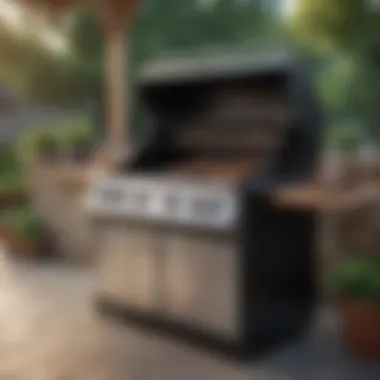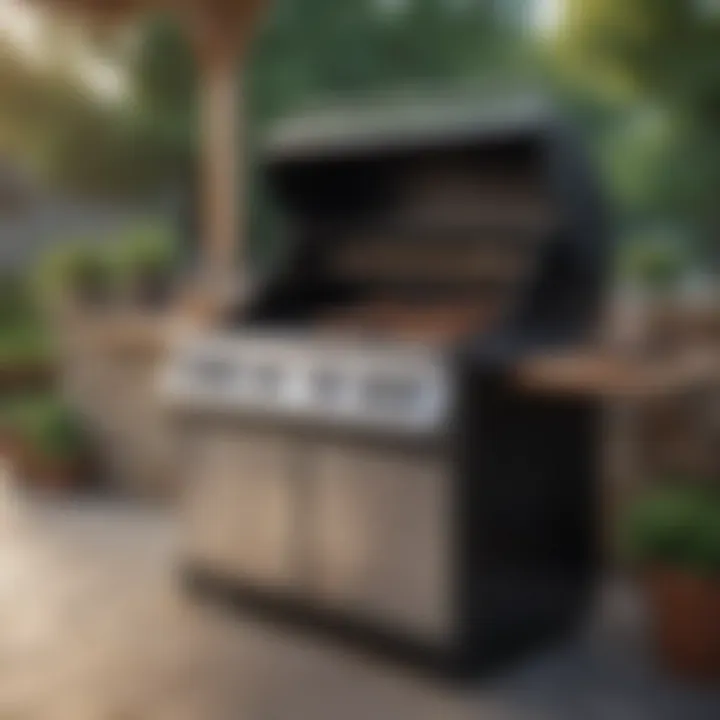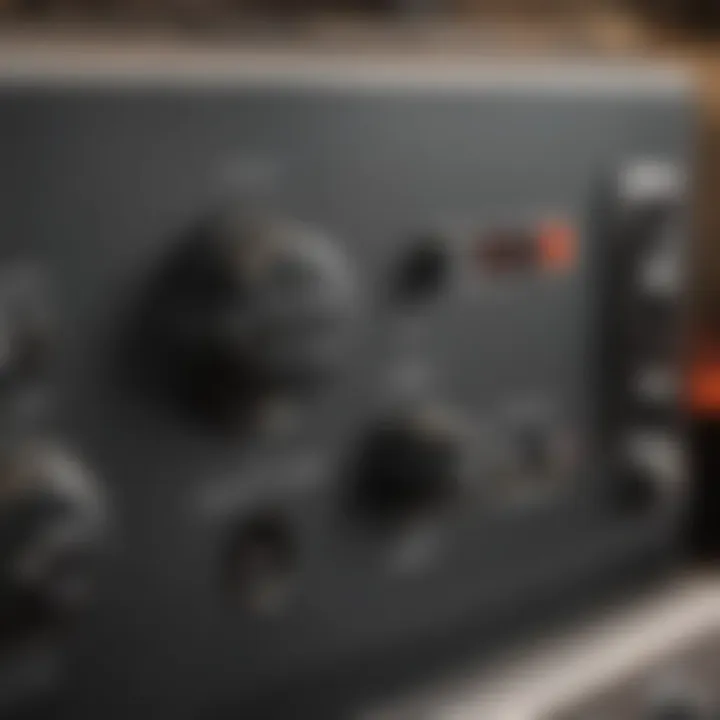Understanding Outdoor Gas Grill BTU Ratings


Intro
Understanding BTU ratings in outdoor gas grills can significantly impact your grilling experience. BTU, or British Thermal Unit, measures the heat output of a grill, helping consumers gauge cooking capabilities and efficiency. This article explores the importance of BTUs in outdoor grilling, how they affect performance, fuel consumption, and efficiency. Additionally, we aim to assist both novices and seasoned grill enthusiasts in selecting an outdoor gas grill that aligns with their needs, while providing essential maintenance and safety tips.
The Importance of BTU Ratings
BTU ratings serve as a fundamental component in assessing outdoor gas grills. A higher BTU usually indicates a grill capable of producing intense heat, which is vital for certain cooking methods, such as searing meats quickly. However, it is crucial to note that a higher BTU does not always equate to a better grill. Factors such as grill design, heat distribution, and intended cooking style must also be considered.
When selecting an outdoor gas grill, potential buyers should thoroughly examine the BTU rating alongside other grill attributes. Understanding how BTUs influence cooking temperature and timing can lead to more enjoyable and successful grilling experiences.
"A grill with a low BTU but excellent heat retention can outperform a high BTU grill in various cooking scenarios."
Factors Influencing BTU Selection
Several variables impact the effectiveness of BTU ratings in grills. These factors include:
- Grill Size and Design: Larger grills may require higher BTUs to maintain even cooking temperatures across the cooking surface.
- Type of Cooking: Different cooking techniques demand specific BTU levels. For instance, grilling burgers may require less BTU than roasting or smoking.
- Fuel Type: Propane and natural gas grills may have different BTU outputs. Propane generally offers a higher BTU rating than natural gas per cubic foot.
- Heat Distribution: Some grills feature advanced distribution systems that ensure even heat across the surface, effectively maximizing BTUs.
Choosing the Right Gas Grill Based on BTU
Selecting the right gas grill involves understanding your cooking preferences and matching them with appropriate BTU ratings. Here are a few tips to guide your decision:
- Consider Cooking Style: If you enjoy searing, opt for grills with a higher BTU output.
- Evaluate Climate Conditions: Colder environments may require higher BTUs to maintain temperature.
- Understand Manufacturer Specifications: Investigate if the brand offers BTU testing data. Reliable brands provide clearer insights into their products.
- Read Consumer Reviews: Testimonials can offer valuable perspectives on real-world performance regarding heat output and fuel consumption.
Maintaining Optimal Grill Performance
Proper maintenance of an outdoor gas grill is crucial for ensuring consistent performance and longevity. Here are some practical steps to consider:
- Regular Cleaning: Remove grease and food particles after each use to prevent flare-ups.
- Check Fuel Connections: Inspect hoses and connections for leaks or damage regularly.
- Monitor BTU Efficiency: Keep a record of fuel consumption to evaluate whether the grill operates at its intended BTU rating.
- Season Your Grill: Like cast iron skillets, regular seasoning can help maintain grates and prevent food from sticking.
Safety Considerations in Gas Grilling
Grilling poses safety risks, particularly with gas grills. Here are safety tips to keep in mind:
- Ventilation: Always grill outdoors in a well-ventilated area to prevent gas buildup.
- Check for Gas Leaks: Use soapy water on connections before every use to identify leaks.
- Keep Children and Pets Away: Establish a safe distance for non-adults to prevent accidents.
- Use Appropriate Utensils: Long-handled utensils are essential for safe cooking.
By understanding the implications of BTU ratings in outdoor gas grills, consumers can make informed decisions that enhance their grilling endeavors. The intersection of BTU efficiency, cooking style, and maintenance practices plays a pivotal role in achieving optimal grilling performance.
Intro to Outdoor Gas Grills
Outdoor gas grills have become a staple in many households, offering an easier and more efficient way to cook outside. The importance of discussing outdoor gas grills lies not just in their popularity, but in the versatility and convenience they provide. With the ability to control heat precisely, they cater to various cooking needs, from searing steaks to roasting vegetables. This guide will dive deeper into how these grills function and their impact on the overall outdoor cooking experience.
The Evolution of Outdoor Cooking
Originally, outdoor cooking involved simple methods such as open fire pits or charcoal grills. As time passed, technology evolved, leading to the introduction of gas grills that operate on propane or natural gas. This evolution significantly changed how people engage with grilling. Gas grills provide a quicker heat-up time, consistent temperatures, and easier cleanup compared to their charcoal predecessors. These advancements have made outdoor grilling more accessible and appealing. Today, outdoor cooking is not just about food; it has transformed into an social activity, a way to bond with family and friends in a relaxed atmosphere.
Benefits of Using Gas Grills
Gas grills present numerous advantages that make them an option for many grill enthusiasts:
- Temperature Control: With gas grills, maintaining a consistent temperature is simpler. This allows for evenly cooked meals.
- Convenience: Lighting a gas grill is typically quicker than starting a charcoal grill. There is little waiting time, enhancing the overall cooking experience.
- Versatility: Many gas grills come with additional features such as side burners and rotisserie attachments, making them suitable for various cooking styles.
- Ease of Cleanup: Gas grills produce less ash and residue compared to charcoal grills, making the post-cooking cleanup process much easier.
"The flexibility of gas grills facilitates spontaneity in cooking, making them a favorite among those who enjoy outdoor gatherings."


What is BTU?
Understanding BTU is crucial when selecting an outdoor gas grill. The British Thermal Unit measures heat energy. Specifically, it indicates how much energy a grill can generate. A proper grasp of BTU allows users to assess not just heating power, but also cooking efficiency and fuel use.
Defining BTU in Grilling Context
When we talk about BTU in grilling, we refer to the energy required to increase the temperature of one pound of water by one degree Fahrenheit. In grilling, a higher BTU rating often suggests more heat output. However, it is vital to understand the context. Higher BTU does not automatically equate to better performance. It also depends on the grill's design and heat distribution.
Grills with superior materials may deliver better cooking performances at lower BTU levels. Therefore, BTU acts as a guide but should not be the only metric considered when assessing grill quality.
Calculating BTU Requirements
To calculate BTU requirements, one must consider several factors:
- Cooking Style: How you grill will influence your BTU needs. High-heat grilling differs from low-and-slow methods. Different styles require different energy outputs.
- Grill Size: Larger grills often require higher BTU ratings to ensure even cooking across a wider surface.
- Climate Factors: In colder environments, additional BTUs may be necessary to achieve desired temperatures. Wind and elevation also play a significant role.
A rough formula to estimate your grill’s BTU needs is to multiply the width of the cooking surface in inches by 100. This provides a baseline. For example, a 24-inch grill would ideally have 2400 BTUs to heat sufficiently. It is essential to adjust this number based on personal cooking preferences, grill type, and local conditions.
The Importance of BTU Ratings
Understanding BTU ratings is crucial for anyone serious about outdoor cooking. BTU, or British Thermal Unit, is a measure of heat energy. It directly impacts the performance of gas grills. Higher BTU values can indicate faster heating and cooking times, which can be beneficial for food preparation. However, higher BTU does not always equal better barbecue results.
The significance of BTU ratings extends beyond initial heat. It influences how efficiently a grill operates and ultimately affects the grilling experience. It’s essential to understand these ratings when selecting a grill, as they help align the grill's capabilities with individual cooking styles and preferences.
Impact on Heating Efficiency
Heating efficiency refers to how quickly and evenly a grill can reach desired cooking temperatures. BTU ratings play a central role in this process. A grill with a higher BTU rating generally heats up faster. For example, a propane grill rated at 30,000 BTUs may reach grilling temperature within minutes, whereas a lower-rated model could take significantly longer. This quick heating effect can save time, particularly for those who frequently host outdoor cookouts or barbecues.
Moreover, heating efficiency is not only about time; it also concerns how uniformly heat is distributed across the cooking surface. Uneven heating may lead to burnt or undercooked food. Therefore, while a grill’s BTU rating is important, evaluating the overall design and material of the grill is equally important. Grills like the Weber Genesis II series are designed to promote even heat distribution, which enhances the cooking efficiency alongside the BTU rating.
Influence on Cooking Performance
Cooking performance encompasses various factors, including temperature control, heat retention, and food flavor. A grill with an optimal BTU rating can enhance the cooking performance significantly. For instance, a high BTU rating allows for quicker searing of meats, which can lock in juices and flavor.
Conversely, a grill with too high of a BTU rating for its size may lead to burnt exterior and raw interior, especially with thick cuts of meat. For grilling enthusiasts, understanding their specific cooking needs helps in selecting the right grill. For example, those who prefer slow-cooking or smoking may find a grill with lower BTU ratings more suitable.
Furthermore, controlling heat is vital. Grills equipped with adjustable burners can offer flexibility. For instance, the Char-Broil Performance series features burners that can be dialed down effectively, allowing users to manage cooking temperatures for various foods.
Relation to Fuel Consumption
Fuel consumption is another critical aspect related to BTU ratings. Higher BTU ratings usually mean greater fuel usage. While powerful grills can offer impressive cooking speeds, they may also lead to higher gas bills if used excessively without consideration of efficiency. Understanding how many BTUs are consumed per hour of cooking is essential for budgeting and planning.
Occasionally, a grill may be marketed as high BTU but can lead to waste due to poor design. Therefore, evaluating how the grill uses its BTUs efficiently can help inform purchasing decisions.
In summary, a balance needs to be struck between BTU ratings, cooking habits, and overall fuel management. Grilling enthusiasts must align their grilling needs with the grill’s specifications to achieve the best results.
Choosing the Right BTU for Your Grill
Choosing the right BTU is critical when selecting an outdoor gas grill. The BTU rating indicates how much heat the grill can produce, affecting cooking speed and efficiency. A higher BTU does not always guarantee superior grilling capabilities. Instead, it's about finding a balance tailored to your needs and preferences. Understanding what BTUs mean for your cooking setup can enhance your outdoor grilling experience.
Factors Affecting BTU Needs
Several factors can influence your BTU requirements. Firstly, the size of the grill plays a pivotal role. Larger grills require more heat to ensure even cooking across the cooking surface. The type of food you typically prepare also matters; thicker cuts of meat demand more heat for proper cooking. Another aspect is the environment in which the grill will be used. A windy area can lead to heat loss, necessitating a higher BTU output to maintain steady cooking temperatures.


Size and Cooking Style Considerations
When considering size, a grill with a surface area of 500 to 600 square inches is suitable for families or small gatherings. However, if you often host larger parties, look for grills over 700 square inches, as they provide more versatile cooking options. Your cooking style also impacts BTU needs. If you prefer slow cooking or smoking, lower BTUs can be effective. Conversely, if you favor searing meats quickly, selecting a grill with a robust BTU rating is vital.
Recommended BTU Ranges
As a general guideline, a good BTU range for typical outdoor grilling is between 30,000 to 50,000 BTUs. This range delivers ample power for most cook-offs while preserving the heat necessary for searing and quick dishes. If you often grill in colder conditions or at higher altitudes, aiming for BTUs at the higher end of the spectrum may be wise. Ultimately, it’s crucial to align your choice with how you grill, thus creating a more satisfying outdoor cooking experience.
BTU and Grill Types
Understanding BTU ratings can significantly enhance the overall experience of outdoor grilling. Different grill types, including propane gas grills, natural gas grills, and infrared grills, each bring unique features and benefits to the table. The importance of BTU becomes clear when considering how it influences performance, cooking methods, and user preferences. Identifying the right BTU rating for each type of grill helps maximize efficiency and safety, ensuring that your outdoor cooking endeavors are successful.
Propane Gas Grills
Propane gas grills are among the most popular options for outdoor cooking. They generally have a higher BTU rating compared to other grill types, making them ideal for searing and achieving high temperatures quickly.
One notable advantage of propane grills is their portability. They can be easily moved and set up in various locations, which is convenient for tailgating or camping. A BTU range of 30,000 to 50,000 is common for propane grills, which provides sufficient heat for most grilling needs.
However, too high a BTU can lead to uneven cooking. It is important to balance heat levels and to consider cooking techniques. For instance, lower settings are often more suitable for slow cooking or smoking, while higher BTUs are great for quick grilling. Regular maintenance is also key to maintaining the efficiency of these grills.
Natural Gas Grills
Natural gas grills offer a different set of benefits. They connect to a home gas line, providing an uninterrupted source of fuel which can be more cost-effective in the long run. Natural gas grills typically feature a lower BTU output than propane grills, with a range of 25,000 to 40,000 BTUs.
Despite the lower BTU, natural gas grills can still achieve high cooking temperatures. Users should consider factors such as grill design and heat distribution. Even though these grills provide a constant supply of gas, they still require proper connectivity and installation.
One downside is the lack of portability. Once installed, moving a natural gas grill can be a hassle. Nonetheless, for homeowners who often grill, these grills can be a reliable choice for daily use.
Infrared Grills
Infrared grills represent a modern approach to outdoor cooking. They utilize infrared technology to create heat, which is typically more efficient than traditional grilling methods. Infrared grills often have BTU ratings that can vary widely, usually ranging from 30,000 to over 100,000 BTUs.
The significant advantage of infrared grills is their ability to give off intense and even heat. This leads to faster cooking times and excellent browning on meats. Infrared grills also produce juicier results due to the rapid cooking time, which seals in moisture.
However, they might not be suitable for all types of grilling, such as indirect cooking or smoking. Users should gauge their grilling preferences when selecting an infrared grill. Familiarizing oneself with the unique characteristics of infrared technology is essential for maximizing the grilling experience.
Selecting the right grill type based on BTU ratings is crucial for achieving optimal cooking results.
In summary, understanding the relationship between BTU ratings and different grill types is fundamental to choosing the right outdoor gas grill. Each grill type has its own peculiarities and benefits, and aligning those with personal cooking styles will lead to better results in outdoor culinary endeavors.
Fostering Optimal Grill Performance
Fostering optimal grill performance is essential for any grill enthusiast. The effectiveness and efficiency of an outdoor gas grill hinge not only on its BTU rating but also on how well it is maintained and utilized. Optimal performance ensures that food is cooked evenly and efficiently, enhances flavor, and minimizes waste of fuel. There are several key aspects to consider when aiming to optimize your grilling experience.
Regular Maintenance Practices
Regular maintenance practices significantly contribute to the longevity and performance of your gas grill. Routine checks and cleaning are vital. This includes:
- Cleaning the grates: Grease and food remnants can hamper heat distribution. Use a grill brush to clean the grates thoroughly after each use.
- Inspecting the burners: Examine for clogs or rust. Proper function of burners ensures even heating.
- Checking gas connections: Leaks can pose serious risks. Ensure connections are secure and check for any signs of wear or damage.
- Cleaning the exterior: A clean grill not only looks appealing but also maintains its condition. Use appropriate cleaners to keep the surface spotless.
Performing these maintenance tasks regularly can help prevent larger issues down the line, ensuring your grill operates effectively every time you use it.
Temperature Control Techniques


Temperature control is crucial to achieving great grilling results. Understanding how to manage heat can affect cooking times and food quality.
- Preheating the grill: Always preheat your grill before placing food on it. This practice helps to create a nice sear and locks in flavors.
- Using a thermometer: Invest in a good digital thermometer to monitor internal temperatures. This tool provides a more accurate read compared to built-in gauges.
- Controlling flame levels: Adjust the flame to suit different cooking needs. For example, high heat is ideal for searing meats, while lower heat is better for slow cooking or indirect grilling.
By mastering these techniques, you not only improve the taste and texture of your grilled items but also improve fuel efficiency. Optimal temperature management ensures you make the most of your grilling sessions, leading to better results and a more enjoyable cooking experience.
"Regular upkeep and smart temperature control can elevate your grilling from mundane to exceptional."
Common Misconceptions About BTU
When discussing outdoor gas grills, BTU ratings often emerge as a focal point of conversation. However, misconceptions abound that can mislead consumers. Understanding these misconceptions is crucial for homeowners and gardening aficionados aiming to optimize their grilling experience. Grilling enthusiasts should recognize that the BTU rating is just one piece of a larger puzzle involving grill performance, efficiency, and cooking style.
BTU as the Sole Determiner of Grill Quality
One prevalent myth is the belief that BTU alone determines the quality of a gas grill. Many assume that a higher BTU means a better grill. While higher BTU ratings indicate that a grill can produce more heat, this does not automatically correlate with superior cooking capabilities. Several factors influence grilling performance beyond BTU.
- Heat Retention: The material used in the grill’s construction plays a vital role. A grill made of thicker steel will retain heat better than a lighter one, regardless of BTU ratings.
- Design and Performance Features: Features like the design of burners, heat zones, and cooking grates also impact how well a grill cooks.
- Cooking Style: Different grilling methods require varying amounts of heat. For instance, low-and-slow cooking needs less BTU than searing meat.
In summary, while BTU is important, it is not the sole indicator of a grill's quality.
Understanding Heat Distribution
Another common misconception is that a high BTU guarantees even heat distribution. In reality, heat distribution can vary greatly among grills. A grill might have a high total BTU output but could suffer from hotspots or uneven heating. This can result in poorly cooked food.
- Burner Configuration: The design of the burners significantly affects how heat is dispersed across the cooking surface. Busier designs tend to promote better heat distribution.
- Cooking Surface Area: A larger cooking area with inadequate burners may not distribute heat efficiently, defeating the purpose of a high BTU output.
Effective grilling relies not just on BTU but also on how well the grill manages heat across its cooking surface. Consider both aspects when selecting your grill.
Understanding these misconceptions about BTU helps grill enthusiasts make informed decisions, ensuring their outdoor cooking endeavors are successful. By debunking these myths, one can focus on the overall attributes of the grill, leading to a better grilling experience.
Safety Considerations
Safety is paramount when using outdoor gas grills. Understanding safety considerations helps ensure a risk-free grilling experience for everyone involved. Gas grills utilize high temperatures and pressurized gas, making it crucial to handle equipment properly. Unsafe practices can lead to accidents, injuries, or even property damage. By implementing correct safety measures, one can significantly lower the risk associated with outdoor grilling.
Proper Use of Gas Grills
Using gas grills correctly is essential for both functionality and safety. Start by reading the manufacturer’s manual. This guide contains important information about setting up and operating the grill safely. Here are some key points for proper use:
- Placement of the Grill: Keep your grill outdoors in a well-ventilated area. Avoid placing it under awnings or near flammable materials.
- Inspect Before Use: Before lighting, check the hoses and connections for any signs of wear or leaks. If a leak is suspected, do not attempt to light the grill; instead, apply soapy water to the area and watch for bubbles.
- Lighting the Grill: Turn on the gas first, followed by igniting the burner. If you smell gas, turn off the valves immediately and ventilate the area.
- Monitoring During Cooking: Never leave a lit grill unattended. Fires can ignite quickly, and being present allows you to respond to any issues immediately.
"Proper use of gas grills not only ensures delicious food but also enhances safety for the user and the surrounding area."
Storage and Handling of Propane
Propane is a flammable substance and needs careful handling and storage. Improper storage of propane tanks can lead to serious safety hazards. Below are some best practices:
- Tank Placement: Store propane tanks in an upright position in a cool, dry place. Avoid exposing them to direct sunlight or heat sources to prevent pressure buildup.
- Transportation: When moving tanks, keep them secured and upright in your vehicle. Adhere to local regulations regarding transportation.
- Disconnect When Not in Use: Always disconnect propane tanks when the grill is not in use. This prevents gas leaks and accidents.
- Check Expiry Dates: Propane tanks have expiration dates. Regularly check and replace tanks as necessary. Avoid using tanks that are not up to date on safety regulations.
By prioritizing safety and properly managing both the grill and propane, grill enthusiasts can enjoy a safe and pleasurable cooking experience.
Culmination
In this article, we have explored the intricate relationship between BTU ratings and the performance of outdoor gas grills. Understanding BTU is essential for both novice and seasoned grill enthusiasts. The insights shared throughout this guide highlight the key elements that contribute to a satisfying grilling experience. Key factors include heating efficiency, cooking performance, and fuel consumption. By grasping these concepts, homeowners can appreciate how BTU influences the selection and operation of their grills.
Recap of Key Points
- Definition of BTU: BTU, or British Thermal Unit, measures the amount of heat needed to raise the temperature of one pound of water by one degree Fahrenheit. This metric is vital for evaluating grill performance.
- Importance of BTU Ratings: It affects cooking efficiency. High BTU ratings can mean faster cooking times but might not always translate to better grilling results. Moreover, understanding heat distribution is crucial in achieving even cooking.
- Selecting the Right BTU: The appropriate BTU can vary depending on factors such as grill size, cooking style, and personal preference. It is important to weigh these factors when making a purchase decision.
- Myths Debunked: A higher BTU does not automatically indicate a superior grill. Quality materials and design play significant roles in performance.
- Safety First: Grilling entails safety considerations like proper use of gas grills and correct storage of propane to avoid accidents.
Final Thoughts on Selecting Outdoor Gas Grills
Choosing the right outdoor gas grill involves more than just focusing on BTU ratings. While these ratings provide a guideline for heat output, they do not encompass the entire picture. Homeowners should consider their own cooking habits, the types of food they enjoy grilling, and space availability. Additionally, investing in a grill with reliable construction and features that enhance usability will lead to a more enjoyable grilling experience.







